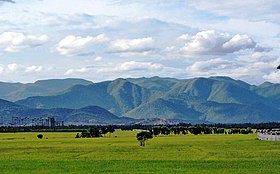Western Ghats
| Western Ghats | |
|---|---|
| Sahyadri | |

Western Ghats as seen from Gobichettipalayam, Tamil Nadu
|
|
| Highest point | |
| Peak | Anamudi (Eravikulam National Park) |
| Elevation | 2,695 m (8,842 ft) |
| Coordinates | 10°10′N 77°04′E / 10.167°N 77.067°ECoordinates: 10°10′N 77°04′E / 10.167°N 77.067°E |
| Dimensions | |
| Length | 1,600 km (990 mi) N–S |
| Width | 100 km (62 mi) E–W |
| Area | 160,000 km2 (62,000 sq mi) |
| Geography | |
| Country | India |
| States | |
| Regions | Western India and Southern India |
| Settlements | |
| Biome | Tropical and subtropical moist broadleaf forests |
| Geology | |
| Age of rock | Cenozoic |
| Type of rock | Basalt, Laterite and Limestone |
| Official name | Natural Properties - Western Ghats (India) |
| Type | Natural |
| Criteria | ix, x |
| Designated | 2012 (36th session) |
| Reference no. | 1342 |
| State Party | India |
| Region | Indian subcontinent |
Western Ghats (also known as Sahyadri meaning The Benevolent Mountains) is a mountain range that runs parallel to the western coast of the Indian peninsula, located entirely in India. It is a UNESCO World Heritage Site and is one of the eight "hottest hot-spots" of biological diversity in the world. It is sometimes called the Great Escarpment of India. The range runs north to south along the western edge of the Deccan Plateau, and separates the plateau from a narrow coastal plain, called Konkan, along the Arabian Sea. A total of thirty nine properties including national parks, wildlife sanctuaries and reserve forests were designated as world heritage sites - twenty in Kerala, ten in Karnataka, five in Tamil Nadu and four in Maharashtra.
The range starts near the border of Gujarat and Maharashtra, south of the Tapti river, and runs approximately 1,600 km (990 mi) through the states of Maharashtra, Goa, Karnataka, Kerala and Tamil Nadu ending at Kanyakumari, at the southern tip of India. These hills cover 160,000 km2 (62,000 sq mi) and form the catchment area for complex riverine drainage systems that drain almost 40% of India. The Western Ghats block southwest monsoon winds from reaching the Deccan Plateau. The average elevation is around 1,200 m (3,900 ft).
The area is one of the world's ten "Hottest biodiversity hotspots" and has over 7,402 species of flowering plants, 1,814 species of non-flowering plants, 139 mammal species, 508 bird species, 179 amphibian species, 6,000 insects species and 290 freshwater fish species; it is likely that many undiscovered species live in the Western Ghats. At least 325 globally threatened species occur in the Western Ghats.
...
Wikipedia
